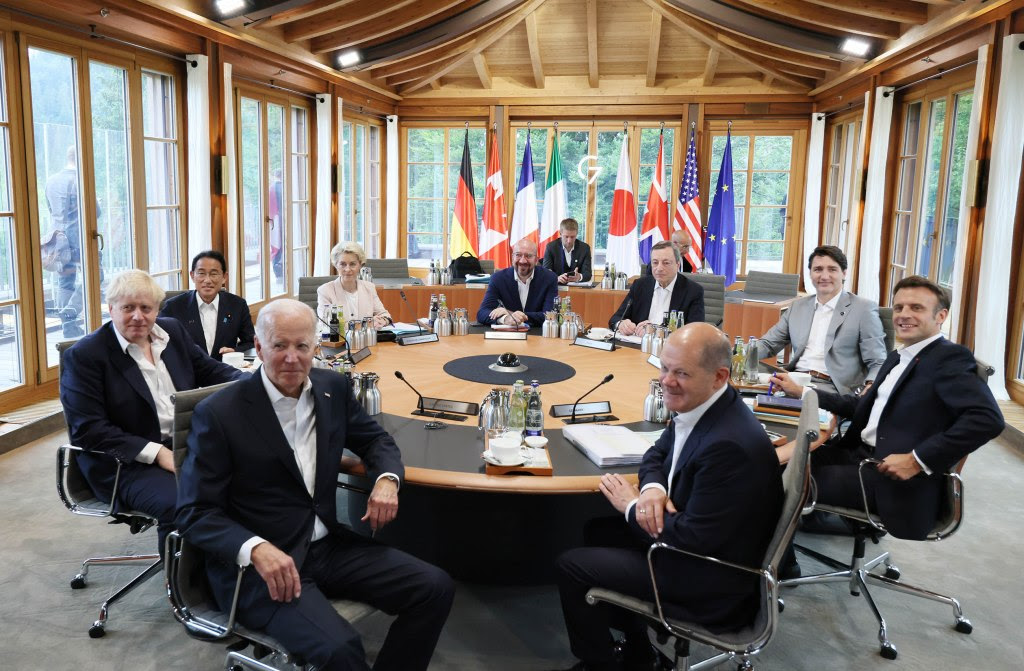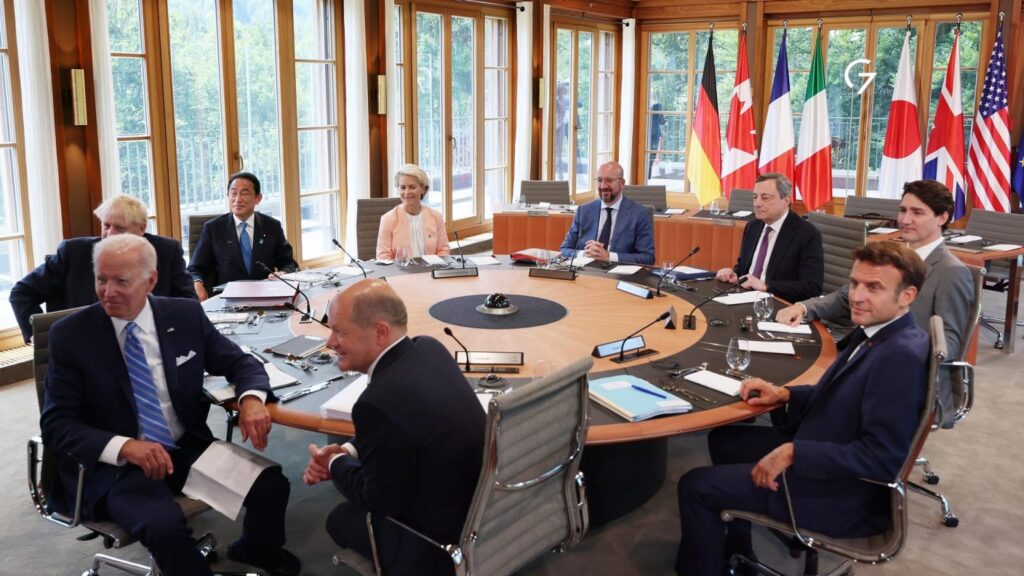11 Jan 2023 – Western sanctions led Russia to greatly increase trade with Asia, while devastating Europe’s economy. The US tech war against China is damaging its own industry.
Economic coercion, through the imposition of sanctions, is an act of war. Many of these sanctions have caused hardship, especially for the civilian populations of targeted countries.
But just as a rifle recoils on the shooter’s shoulder, potentially causing injury, so too can sanctions backfire on the user. That is the title of a new book, “Backfire: How Sanctions Reshape the World Against U.S. Interests.”
This is not to say that sanctions don’t cause suffering, but they have a mere 13% success rate in altering a targeted state’s behavior in the way desired.
The failure of sanctions has long been recognized, although that seems not to have dampened U.S. persistence in adding ever more of them.
The blowback effect has begun, and more is predictably on the horizon. This present analysis will focus on the two main geopolitical targets of U.S. policy: Russia and China.
‘Extending’ Russia into Ukraine
At the moment, the U.S. is in a proxy war with Russia, with Ukraine in the military forefront. Before that, and alongside it now, is a running war of sanctions.
The longest cause was the rise to power of Vladimir Putin, who restored Russia’s economic power and sovereignty by undoing some of the predatory effects of Russia’s privatization following U.S.-supported “shock therapy.”
An early “Western” strategy to prevent a return of Russia as a great power was to bring many of its bordering states in Eastern Europe into NATO. Ukraine would be the last piece in what Russia perceives to be a military front of potential aggression. Whatever the outcome of that fight will be, sanctions are likely to continue.

The U.S. first sanctioned 60 Russian individuals in 2012 with the Magnitsky Act, to punish those supposedly responsible for the death of Sergei Magnitsky, an accountant for a tax-evader who was charged with corruption, and who was also politically linked to Russian opposition leader Alexei Navalny – himself later a cause for further sanctions.
In 2014, a U.S.-backed coup in Ukraine led to eight years of civil war, giving rise to separatist movements in the east of the country.
Apparently following the 2019 report “Extending Russia” from the Pentagon-backed RAND Corporation, the U.S. selected Ukraine as the best option among neighboring countries to provoke Russia into over-extending itself.
This proposed strategy seemed confirmed in December 2022 by Germany’s former chancellor, Angela Merkel, in an interview with the newspaper Die Zeit. She admitted that the “2014 Minsk agreement was an attempt to buy time for Ukraine. Ukraine used this time to become stronger.”
The Minsk agreements had been overseen by Germany and France. Former French President François Hollande confirmed the same soon after, stating, “Angela Merkel is right on this point.”
Their strategy succeeded in “extending Russia” into Ukraine in February 2022.

Fumio Kishida attended a roundtable meeting on Day 3 of the G7 Schloss Elmau Summit.
首相官邸ホームページ, CC BY 4.0 https://creativecommons.org/licenses/by/4.0, via Wikimedia Commons
Western sanctions lead to more Russian self-sufficiency
Sanctions have been raining down on Russia ever since, against individuals, companies, and government agencies, most importantly against its oil exports, but also against its sale of aluminum, uranium, and agricultural goods.
Initial harm included a sizeable drop in Russia’s GDP and living standards, the loss of foreign investment, a sharp increase in inflation, and a temporary depreciation of the ruble.
The U.S. later restricted Russia’s access to capital markets and to oil and gas extraction technology, which can inhibit Moscow’s financing of oil field development, notably in the Arctic, where Russia has the longest shoreline.
However, Putin turned much of this around with policies of import substitution, government subsidies, and the nationalization of private oil companies, which by 2018 had grown back up to almost 40% more than before sanctions.1
In fact, the value of Russian exports grew after the 2022 sanctions.
Russian farmers gained from import substitution and ensured the country’s food security.
And while Russia exports less now to Britain, Sweden, the U.S., South Korea, and Germany, it exports more to Brazil, Japan, China, India, Turkey, Spain, the Netherlands, and Belgium.
India and China have increased their purchase of Russian oil; France relies on Russian uranium; Belgium still trades in diamonds with Russia; and the Netherlands offers access to Dutch ports for such cargo, the New York Times reported.
While Russia’s exports to the U.S., the United Kingdom and other markets have fallen, its trade with China, India, Turkey and even Belgium and the Netherlands has boomed, driven in part by higher energy prices this year. https://t.co/MJLmBYdzzV pic.twitter.com/dbc4VYtSXw
— The New York Times (@nytimes) November 2, 2022
Financial sanctions have also fallen short of their goal.
The Bank of Russia’s reserve system has a surplus of pre-war levels. By the end of 2022, Russia’s foreign-exchange reserves were $581.7 billion USD, the fourth-highest in the world – while its ally China remained firmly in first place, with more than $3 trillion USD worth of assets.
Western sanctions on Russia backfire in Europe
By contrast, Germany is facing the most collateral damage from the loss to its markets and the sanctions on energy, notably bringing an end to the supply of cheap Russian gas through the Nord Stream 1 pipeline.
In 2020, U.S. Congress imposed secondary sanctions on banks that processed transactions related to the Nord Stream 1 and 2 pipelines and on ship insurers that serviced them.
When construction of Nord Stream 2 was finished in 2021, Washington imposed new sanctions on insurance and certification companies to keep it from opening.
Finally, both pipelines were sabotaged in an undersea explosion in September 2022.
As a result, the industries that had made Germany preeminent in Europe, such as steel, chemicals, machinery, and automotives, are suffering from high energy costs and the loss of Russia’s aluminum, titanium, and palladium.
As a consequence, one in four German companies is considering moving production to other countries, amid the energy crisis.
While European nations like Germany and France appear publicly to support U.S. attempts to weaken the Russian government, they are furious at the cost to themselves in the form of lost trade agreements and investment opportunities.
EU leaders are furious that the US is making lots of money from the proxy war in Ukraine by selling weapons and expensive natural gas
Meanwhile European industries are being destroyed as high energy prices and US subsidies push its companies overseas https://t.co/cgtLK0ONC0
— Geopolitical Economy Report (@GeopoliticaEcon) December 11, 2022
Their unease is compounded by suspicion of U.S. cupidity in substituting its energy sources – like liquified natural gas (LNG), which is several times more expensive – for cheaper Russian ones, and by record U.S. profits from selling more weapons.
Furthermore, the Joe Biden administration’s attempt to re-shore manufacturing through its “Made in America” policy has led U.S. allies to charge that such protectionism violates international trade laws.
In addition to the mounting costs of production due to the higher price of U.S. energy, this could push Europe into relative deindustrialization.
Some countries have reacted by moving their factories to the U.S. to take advantage of the “Inflation Reduction Act”, which would subsidize a factory in the U.S. by up to $800 million.
A move to the U.S. may save some companies, but will only further deindustrialize Europe.
Another strategy being considered is European protectionism, which may put the trans-Atlantic political alliance on shakier footing.2
Western sanctions fuel Asian integration
It is not just Europe that is mobilizing against U.S. protectionism. China, much of Southeast Asia, and some Latin American countries are acting similarly.
The Regional Comprehensive Economic Partnership (RCEP) is a political and economic union created by the Association of Southeast Asian Nations (ASEAN). Larger than the European Union and the U.S.-Mexico-Canada Agreement, RCEP includes China, the Philippines, Laos, Vietnam, Brunei, Cambodia, Singapore, and Thailand, as well as U.S. political allies Australia, New Zealand, Japan, and South Korea.

Members of the Regional Comprehensive Economic Partnership (RCEP) trade bloc
Of course, this pits political and economic interests against each other in some cases, causing tensions that are a feature of blowback to U.S. economic coercion.
The U.S. Congress has also used the financial sector to enforce its policies, imposing secondary sanctions on banks that process transactions with sanctioned parties.
Secondary sanctions are imposed on countries that attempt to trade with the targets of primary sanctions. They are technically illegal, but many countries observe them out of fear of U.S. retaliation.
Importantly, shipping companies and insurers often over-comply with sanctions that may not technically apply, which has delayed shipments of grain and fertilizer that are needed to prevent famine, notably in Africa.
However, blowback looms in global finance, which could eventually erode U.S. power as exercised through the hegemony of the dollar.
Western sanctions accelerate development of new financial systems
One of the ways to avoid primary and secondary sanctions is by trading in local currencies, rather than by using SWIFT (Society for Worldwide Interbank Financial Telecommunications), a member-owned system made up of banks and financial institutions worldwide, widely used for transactions that are denominated in dollars.
SWIFT blocks payments that breach U.S. sanctions. Thus, more and more countries are trading in other currencies.
Russia trades with India in rubles and rupees, and with China in rubles and renminbi.
Also trading in national currencies are members of the Shanghai Cooperation Organization, which includes China, India, Pakistan, Russia, Iran, and numerous Central Asian states, making up half the world’s population.

The 2022 meeting of the heads of state of the members of the Shanghai Cooperation Organization
Alternative financial networks are being formed. The BRICS countries (Brazil, Russia, India, China, South Africa) are working to develop a new reserve currency based on a basket of their national currencies.
China has formed CIPS (Cross-Border Interbank Payment System), a SWIFT-like payment network to internationalize the renminbi. Its co-founders included even some Western banks like Citi, Deutsche Bank, HSBC, along with numerous Asian and African banks. With about 1,300 banks in all, it is a challenge for the future.3
China is slowly edging its Renminbi into becoming an international currency, which would push the dollar into being only one member in a basket of currencies, rather than the dominant currency used in trade.
Finally, there is the growth of digital currencies – electronic state-backed national currencies that act like cash, not to be confused with blockchain cryptocurrencies.
National digital currencies will allow countries to trade directly, without having to go through mechanisms like SWIFT.
The decline of dollar hegemony is expected, but with a long time horizon of two or three decades.
However, the weaponization of finance has cost the U.S. a loss of trust. When foreign reserves can be frozen, as they have been for Russia, Venezuela, Iran, and Afghanistan, then no country can feel that its assets are safe.
Many central banks, including China’s, have been buying gold for their reserves and selling U.S. securities.
US sanctions on China risk global trade war, hurting Western industries
One important, contradictory result of the measures taken so far has been the growing closeness of Russia and China, who now hold joint military exercises.
In terms of Beijing, whose spectacular growth presents a clear challenge to U.S. global dominance, Washington has begun a stronger form of economic coercion: export controls.
Here the danger of blowback is even greater, possibly leading to a long-lasting trade war over semiconductors or microchips, the key to advanced civilian and military technology.
In October 2022, the U.S. Commerce Department barred Chinese chip, biomedical, and chemical companies from importing highly advanced American chip design and manufacturing tools. The goal is to prevent Chinese companies from developing their own ability to manufacture comparable technology.
Should secondary sanctions be applied in this case, other technology companies may be affected – like Samsung and Taiwan Semiconductor Manufacturing Company (TSMC), which trade with China’s large market.
However, a considerable illicit trade of chip smuggling is going on. An amusing, miniature version of this was the attempt to bring in chips in a fake baby bump.
One possible blowback to U.S export controls could be China potentially retaliating by denying the U.S. rare earth minerals that are needed for the batteries used in most modern technological products. China oversees 60% of rare earth production.
U.S. business interests have expressed concern about the consequences, especially given that Washington has failed to persuade its allies to adopt similar export controls.
Moreover, the loss of the China market would be a “death warrant” for some U.S. semiconductor firms, whose decline in revenue could lead them to reduce their investment in research and development, and thus decline.4
Hence, the semiconductor industry prefers a narrower target on China’s defense and security industry.
Finally, who sets the standards for microchips also holds considerable power. Chinese engineers are increasingly influential in the International Organization for Standardization and International Electrotechnical Commission, which gives Beijing a presence in help setting the rules.
China has even set up a competitor to WiFi on its Digital Silk Road. And its global positioning system, Beidou, is three times more accurate than GPS.5
Decoupling into two world systems of technology would probably backfire on many levels. Semiconductor production consists of a highly integrated global network of resource extraction, design and manufacture.
At present, Taiwan’s TSMC has the largest concentration of production, amounting to 92% of the most advanced chips. That makes Taiwan a key factor in the U.S.-China competition. And, for now, it provides the island with a “silicon shield” from military operations.
It is becoming increasingly clear that the U.S. sanctions policies to maintain global dominance, although harmful and escalating, may have passed the peak of their effectiveness.
Export controls could be more effectively destructive, but even their outcome is likely to fall short of the ultimate goal.
Most observers consider that, in two or three decades, the U.S. will have come to terms with being only one of several important powers. The dollar will become one part of a basket of reserve currencies.
The question is if Washington can commit itself to cooperation rather than competition, in matters of concern to humanity at large.
The benefits could be enormous.
Citations:
1 Jeremy Kuzmarov, “Trying to Unbalance Russia: The Fraudulent Origins and Impact of US Sanctions on Russia,” in Davis and Ness, p. 300, citing Richard Connolly, “Russia’s Response to Sanctions: How Western Economic Statecraft is Reshaping Political Economy in Russia,” Cambridge University Press, 2018
2 Rawi Abdelal and Aurelie Bros, “The End of Transatlanticism? How Sanctions are Dividing the West”, in Horizons: Journal of International Relations and Sustainable Development, no. 16, Pandemics & Geopolitics: The Quickening (Spring 2020) pp. 114-135.
3 Agathe Desmarais, Backfire: How Sanctions Reshape the World Against U.S. Interests. Columbia University Press, 2022, pp. 129-131.
4 Desmarais, p. 180.
5 Desmarais, p. 185.
________________________________________________

